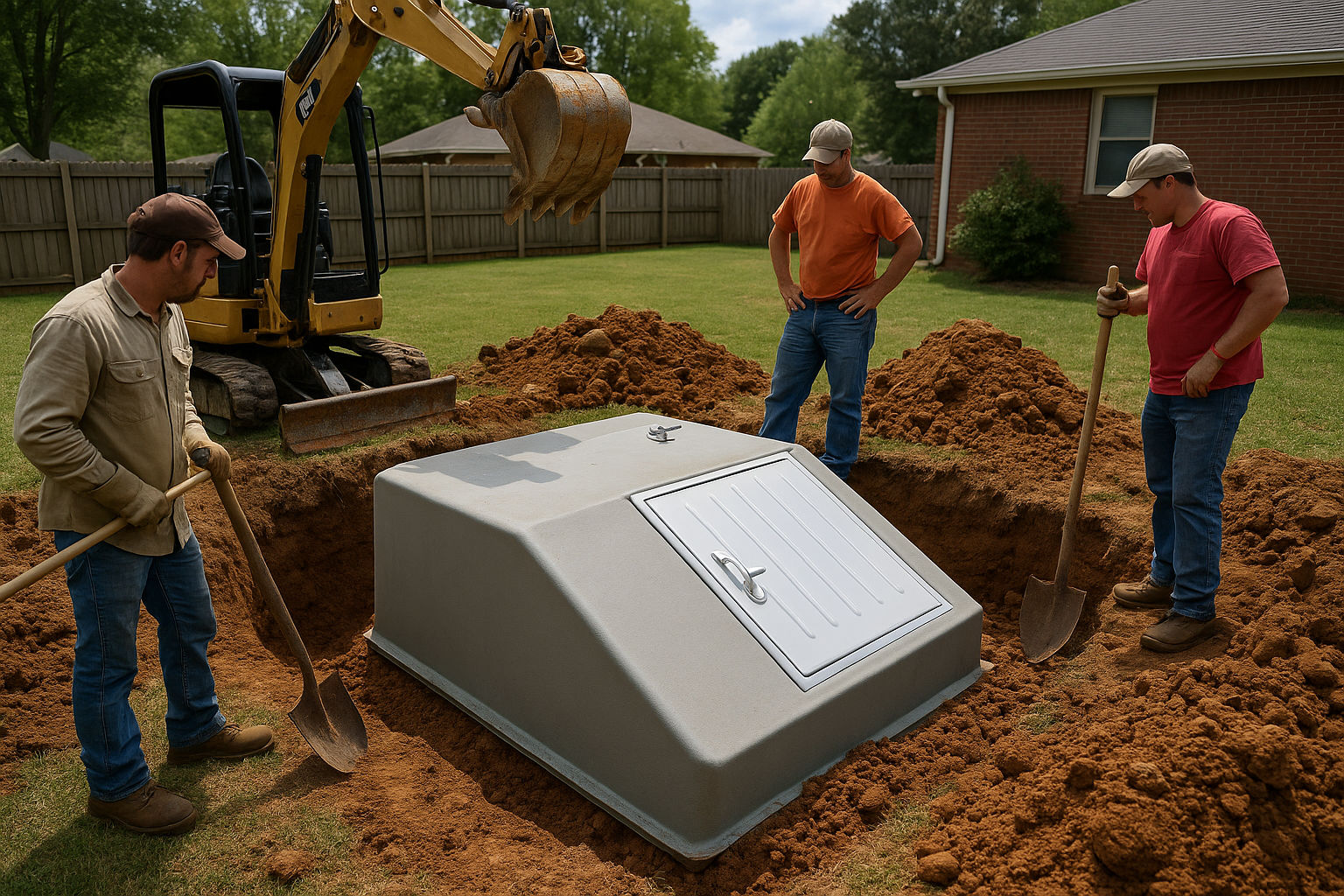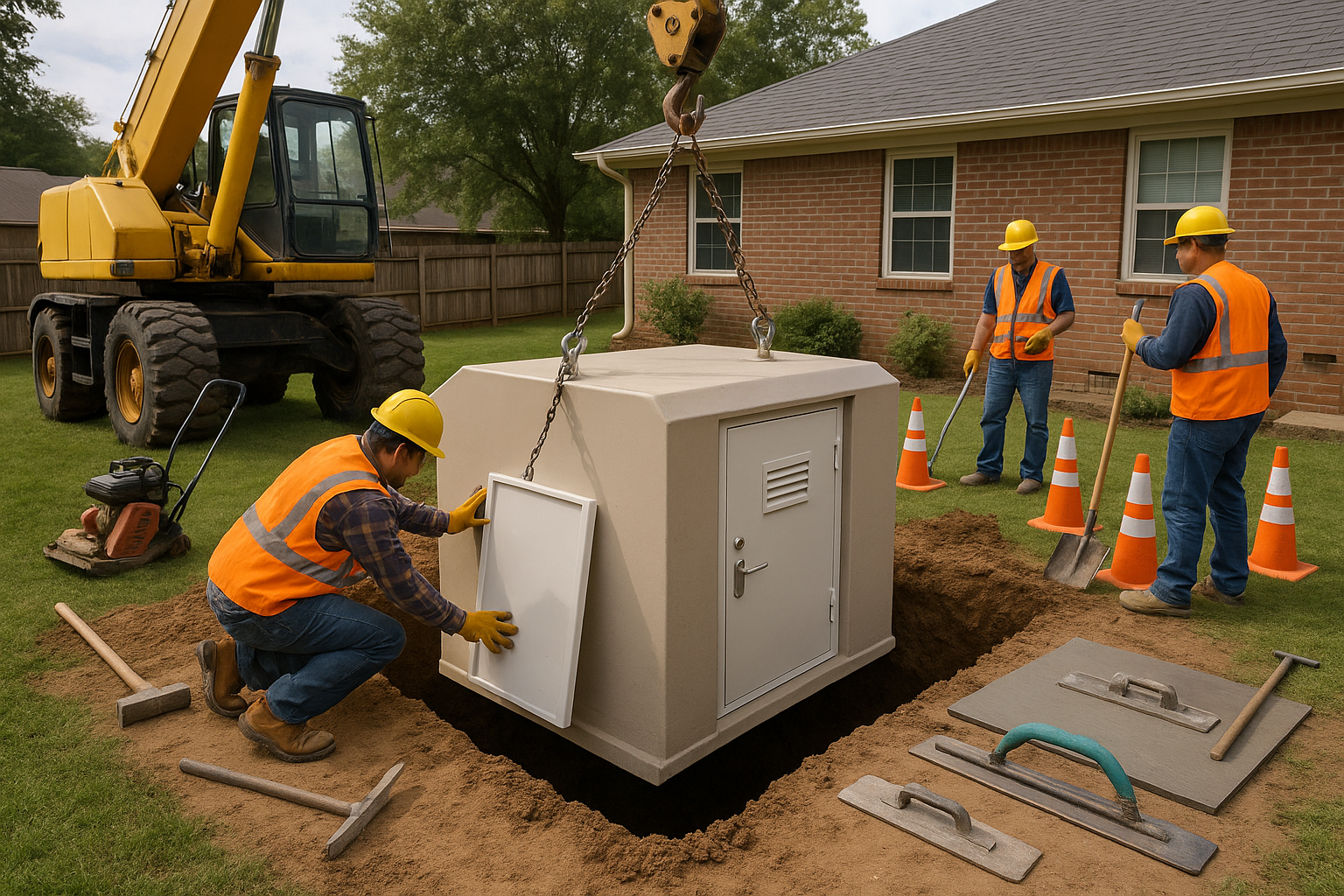How Much Does a Storm Shelter Installation Cost?


Understanding the Real Cost of a Storm Shelter in Alabama
If you’ve lived in Alabama long enough, you know how quickly storms can shift from ordinary to dangerous. The worry sets in: Is my home prepared? Will my family be protected? That’s when many homeowners begin researching storm shelter installation cost and what it truly takes to invest in reliable protection. The cost to install storm shelter options varies widely, and that is often where confusion begins. Between underground models, safe rooms, custom configurations, and the many installation factors involved, the price ranges can feel overwhelming. Yet the truth is simple: understanding the real costs helps you choose a shelter that is both safe and financially reasonable.
By the end of this guide, you’ll know exactly what influences the cost to install a storm shelter, what types of shelters fit your needs, and how Alabama’s soil conditions and tornado activity impact the overall investment. Learning how much does it cost to install a storm shelter gives you confidence and clarity as you move forward with your decision. Let’s break down the numbers clearly so you can plan with certainty.
What Impacts the Cost of Installing a Storm Shelter in Alabama?
When homeowners first compare shelter prices, it is easy to get stuck on the initial sticker shock. But the storm shelter installation cost depends on more than just the shelter unit. Several key elements directly influence the final project price, and understanding them helps you avoid surprises later.
Here are a few of the biggest factors that influence cost:
Shelter type and size: Larger structures and steel-reinforced models naturally cost more. Many Alabama homeowners explore steel safe rooms similar to those found in this collection of safe rooms for long term durability.
Installation location: Backyard, garage, and in-home installations each require unique labor and equipment. The cost to install storm shelter in garage settings depends heavily on concrete cutting and anchoring needs.
Soil and landscape conditions: Alabama’s clay-heavy soil often requires added excavation work. This impacts the cost to install underground storm shelter models significantly.
Safety certifications: FEMA compliance improves reliability and aligns with guidance from FEMA, but it also adds to overall pricing.
These factors combine to form the full cost picture. Some homeowners assume the shelter itself makes up most of the cost of storm shelter installation, but excavation, delivery, labor, anchoring, and ventilation systems can significantly shift the final price. As we explore each component, you’ll see how they affect your budget and why choosing a reputable installer matters.
Breakdown of Storm Shelter Costs for Alabama Homeowners
Understanding Key Cost Factors Clearly
The most common question homeowners ask is simple: What is included in the cost? This step matters because storm shelter pricing can appear inconsistent without proper context. The total storm shelter installation cost Alabama homeowners face typically includes the unit, excavation, concrete work, transportation, anchoring, ventilation, and installation labor. Missing any of these details can skew your expectations.
Once you understand each component clearly, the overall cost becomes more predictable and easier to evaluate.
Breaking Down Material Pricing Clearly
The materials used to build your shelter are one of the most significant cost drivers. Steel units tend to cost more than concrete because they provide long term durability with reduced maintenance. Concrete shelters cost less upfront but often require more labor for sealing, anchoring, and reinforcement. Many homeowners compare concrete and steel options, especially models similar to above ground shelters and unpainted concrete above ground storm shelters available in Alabama.
A typical underground storm shelter ranges from $4,500 to $12,000 depending on size, material thickness, and safety rating requirements.
Estimating Installation Labor Needs Clearly
Labor varies based on the installer’s experience, team size, and required equipment. Underground installations require excavation, reinforcement, and meticulous leveling. Above ground safe rooms require anchoring systems that meet strict standards recommended by organizations like the American Red Cross. In Alabama, labor averages between $1,200 and $3,500 depending on the property layout and shelter type selected.
Evaluating Alabama Soil Conditions Carefully
Soil type plays a vital role in installation difficulty. Much of Alabama contains dense red clay that holds moisture and can complicate excavation. Some locations may even require additional drainage systems to prevent water intrusion in underground shelters. These adjustments add to both labor and materials but ensure the shelter performs safely.
Homeowners researching the cost to install underground storm shelter models often find that soil preparation accounts for a significant portion of their total investment.
Comparing Shelter Type Options Wisely
Different storm shelter types lead to different cost ranges:
Underground shelters: Typically $6,000 to $15,000 installed
Above ground steel safe rooms: $4,000 to $10,000 installed
Garage floor shelters: $5,500 to $12,000 installed
Choosing the right type depends on property layout, mobility needs, and budget. Underground shelters offer low visibility, while safe rooms provide faster access during emergencies. Homeowners interested in underground configurations can explore available models similar to underground storm shelters found throughout Alabama.
How Storm Shelters Are Used in Real Alabama Homes
Now that you understand how cost variables work together, it helps to see how storm shelters fit into everyday Alabama life. Many families rely on these shelters for peace of mind during tornado season. Others integrate safe rooms into new construction, which also improves home value.
Use Case 1: Rural Home Near Lake Martin
A family living outside city limits installed an underground steel shelter in their backyard. With limited nearby emergency services, they needed immediate access and reliable protection. Their storm shelter reduced stress during tornado warnings and gave them a dependable safety plan.
Use Case 2: Suburban Home in Montgomery
A homeowner chose an above ground safe room installed in the garage. They wanted wheelchair access for an elderly family member, which made above ground models similar to those in this collection of community shelters a suitable fit. The result was a safe, accessible shelter that doubled as secure storage during the off season.
These examples show how practical storm shelters can be and how customized solutions improve safety and comfort across different Alabama lifestyles.
Best Practices for Choosing a Storm Shelter Installer in Alabama
Choosing the right shelter and installer ensures your investment delivers long term safety and value. Pricing is important, but certification and installation quality matter just as much.
Tip 1: Confirm FEMA Compliance
FEMA rated shelters meet strict construction and wind resistance standards. Following guidance similar to that available on FEMA.gov ensures maximum safety during tornadoes and extreme wind events. Always verify certification before purchasing.
Tip 2: Ask for a Full Cost Breakdown
A reputable installer should clearly explain labor, materials, excavation, and transportation fees. A transparent breakdown prevents hidden charges and helps you compare quotes using resources like Angi and HomeAdvisor.
Tip 3: Verify Local Experience
Installers familiar with Alabama soil conditions can avoid drainage issues and ensure long term structural integrity. Local experience typically leads to better installation outcomes and lower long term maintenance needs.
Tip 4: Prioritize Access and Convenience
Think about how you will reach the shelter under pressure. Choose a location and shelter design that allows quick, safe access during severe weather. Many Alabama homeowners place shelters in garages or along frequently traveled paths for easy entry.
Making a Smart, Safe Investment for Your Home
Investing in a storm shelter is one of the most meaningful decisions a homeowner can make in Alabama, where storms develop quickly and unpredictably. Understanding storm shelter installation cost helps you plan wisely and choose a shelter that fits both your safety needs and your budget. With the right installer and a clear understanding of your options, protecting your family becomes far easier and far less stressful. When you are ready, explore local providers and take the next step toward dependable storm protection.
Frequently Asked Questions About Storm Shelter Costs in Alabama
1. How much does an average storm shelter cost in Alabama?
Most storm shelters in Alabama range from $4,000 to $12,000 depending on size, materials, and installation needs. Underground models cost more due to excavation, while above ground safe rooms fall on the lower end. This reflects the general cost to install storm shelter options across the state.
2. Is an underground or above ground storm shelter cheaper?
Above ground safe rooms are usually less expensive because they do not require major excavation. Underground shelters cost more but offer enhanced protection and low visibility.
3. Do storm shelters increase home value in Alabama?
Yes, many homebuyers see storm shelters as a premium safety feature. Properties with installed shelters often sell faster and appeal to families who prioritize safety.
4. Are FEMA approved storm shelters more expensive?
FEMA compliant shelters cost slightly more due to reinforced construction and strict testing. However, they offer superior protection and may qualify for grants or insurance benefits.
5. Can I finance a storm shelter installation?
Many Alabama installers offer financing options such as monthly payments or low interest plans. Some local grant programs also help offset the cost of storm shelter installation.



